 |
|||||
| Home | Research | For Teachers | HISTORY Level 1 Level 2 Level 3 |
PRINCIPLES Level 1 Level 2 Level 3 |
CAREER Level 1 Level 2 Level 3 |
| Gallery | Hot Links | What's New! | |||
| Web Administration and Tools | |||||
 |
|||||
| Home | Research | For Teachers | HISTORY Level 1 Level 2 Level 3 |
PRINCIPLES Level 1 Level 2 Level 3 |
CAREER Level 1 Level 2 Level 3 |
| Gallery | Hot Links | What's New! | |||
| Web Administration and Tools | |||||
![]()
The function of the actuating cylinder is to take the pressure and hydraulic fluid flow and change them into either linear or rotary motion. The ones that have been employed more commonly are the double action actuating cylinders, because they work in both directions.
This type of actuating cylinder has one piston connected to one rod. Such a device requires the piston rod to move into the actuating cylinder to cause one motion to occur and to move out of the cylinder to cause the reverse motion to occur.

This is an equal displacement cylinder and could be used on an aileron system or an automatic guidance system (as shown in the second diagram below).
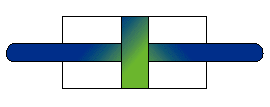
The piston ends can be attached to a pulley system that can pivot a control surface. The motion of the piston to the right, due to high pressure fluid in the left side of the actuating cylinder, can be activate the pulley system and pivot the control surface upward. By reversing the flow, the opposite motion will occur.

This type of actuating cylinder would be used on bomb bay doors (figure shown below right). High pressure fluid enters the center section of the cylinder, acting on the two pistons simultaneously. The rods would be extended outward, causing the doors to rotate open. When the high pressure fluid enters the two end sections (shown in blue), this operation is reversed, closing the bomb bay doors.

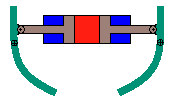
Another application for the Double Piston, Double Rod cylinder is the brake system of a vehicle. Click here to see.
Bungee Type- this type of actuating cylinder is used where gravity or weight can act as high pressure oil. Either a rubber mass or a spring loading device counteracts the weight. Its disadvantages include:
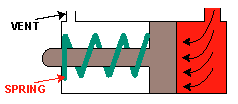

A dashpot cylinder is any cylinder which decelerates piston movement at the end of the stroke. The piston has a small attachment at the piston head side that fits into a dashpot (A). When the piston moves to the left in the diagram below, by forcing the fluid out of the dashpot (A), energy is taken out of the system, causing the piston to slow down.
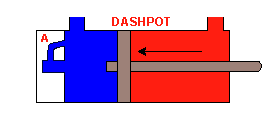
The locking cylinder is a cylinder which has a locking device attached to it. This cylinder is a "fail-safe" design so that it will not actuate beyond some given point.
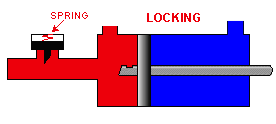
The telescoping cylinder is a cylinder-piston configuration within a cylinder-piston configuration which is used to get a larger stroke from a small cylinder. This may be required when the cylinder must fit into a small space but the piston rod must move through a large distance.
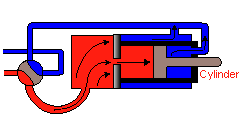
Whenever we don’t want the piston rod to extend into an environment that can damage the rod or contaminate the hydraulic fluid (for example, a stream of sea spray or in the path of little pebbles when landing or taking off from a rough airstrip), we make the piston cylinder extend instead of the piston rod. The type of cylinder we use is the stationary piston moveable cylinder.
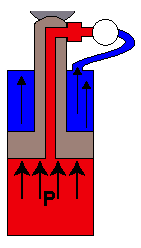
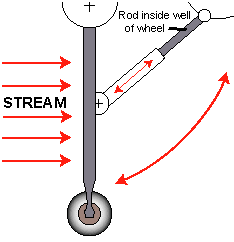
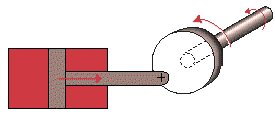
In this type of cylinder, as the piston moves backwards and forwards, it rotates the
rotating cam (circular cam in the center of the diagram). The cam is connected to a
shaft which rotates as well, thus converting the linear motion of the piston into the
rotary motion of the cam and the shaft.
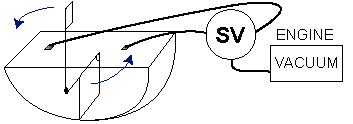
Vacuum rotary windshield wiper
An example of the rotary motion actuating cylinder can be found in certain windshield wiper systems (above). In these windshield wipers systems, as the wiper makes the last part of its stroke, it is designed to trip a selector valve (SV) connection, reversing the air-vacuum flow so that the wiper will reverse direction.
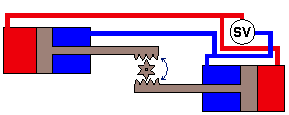
In the double cylinder system shown above, both pistons move in tandem to rotate the gear
shown in the center of the diagram. That gear may be connected to a shaft that
rotates. Thus, we have converted the linear motion of the piston rods into a rotary
motion of the gear.
Send all comments to ![]() aeromaster@eng.fiu.edu
aeromaster@eng.fiu.edu
© 1995-98 ALLSTAR Network. All rights reserved worldwide.
Updated: February 17, 1999